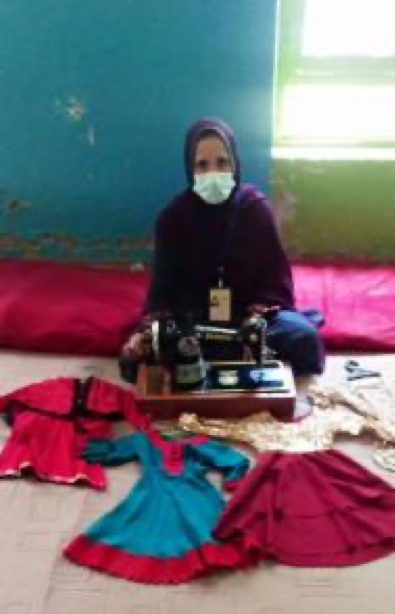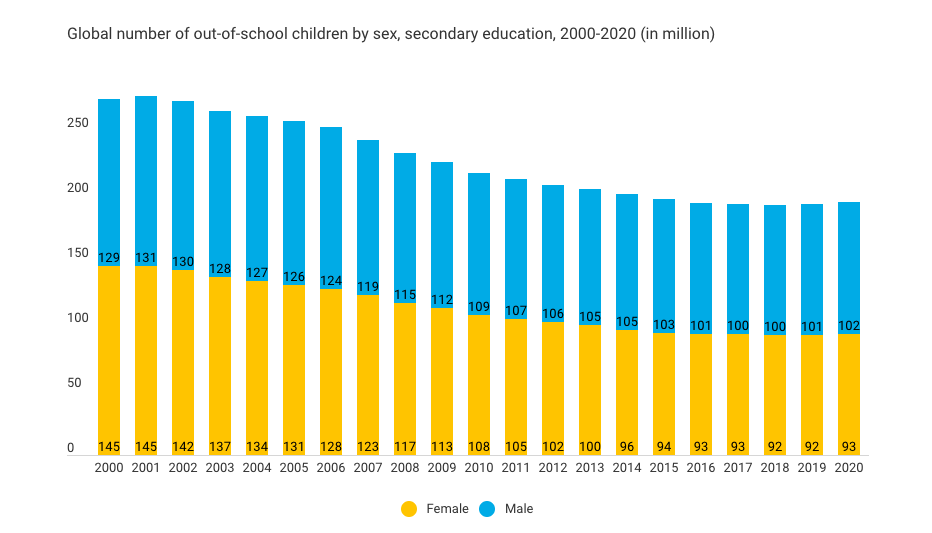Home » Articles posted by Margaret Reagan
Author Archives: Margaret Reagan
Taking Back What is Theirs: Women and Girls’ Access to Education in Afghanistan
Years after the US-led military intervention defeated the Taliban, around 2/3rds of Afghan girls still were out of school (Human Rights Watch, 2017a). Since regaining power in August 2022, the Taliban has banned girls from secondary and tertiary education again (Hadid, 2022). These events have intensified an already dire situation, leaving the future of Afghanistan’s women uncertain and jeopardizing the country’s developmental progress.
Prior to this, an Afghan government report (from 2015) indicated that the number of children attending school exceeded 8 million. However, Human Rights Watch disputed the accuracy of these figures in a report released a few years after (2017a). This is common among post-conflict governments due to displacement and unaccounted populations. This potential inaccuracy is noteworthy because it represents a negative trend in Afghan education as a positive one.

In addition to UN pressure, the Afghan government has legal obligations to supply education to its population. In the Convention on the Elimination of All forms of Discrimination Against Women (CEDAW), Afghanistan ratified that it would ensure women equal rights, including in education (Human Rights Watch, 2017b). This obligation highlights the need for Afghanistan to prioritize and uphold its commitment to equal education. The failure to do so directly violates Afghan women’s rights and impedes the country’s progress toward development.
The Taliban: Brief History
The Taliban was formed in the 1990s by Islamic guerrilla fighters who promised stability after years of conflict (Maizland, 2021). Their beliefs stem from the harsh interpretations of the Pashtuns’ pre-Islamic tribal codes, which require women to be covered entirely, have a male chaperone, and be denied education. In 2001, a U.S.-led invasion ousted this government, and Afghanistan began to see improvement. But by 2021, US troops began withdrawing from Afghanistan, and the Taliban were able to regain control of the country – immediately reinstating these codes.
Education under the Taliban
Afghanistan was already struggling to close gaps in education between boys and girls after the Taliban in 2001. When leaders removed women and girls from schools, this set the country even further back. Additionally, to deter women and girls from attending schools, the Taliban began targeted attacks, such as acid assaults, sexual harassment, and kidnappings (Human Rights Watch, 2017b).

Simultaneously, existing problems inside and outside Afghan schools were intensified.
Inside schools (Human Rights Watch, 2017a):
- Lack of female teachers
- Overcrowding
- Gender segregation
- Poor infrastructure (60% of schools do not have toilets/drinking water)
Outside school (Human Rights Watch, 2017a):
- Gender-based violence
- Partner violence
- Higher costs of attendance
- Increased rate of child marriage
What does this mean for development?
Excluding half a population from education significantly reduces a country’s development. Already in Afghanistan, this has resulted in:
- Losses of up to 5% of Afghanistan’s GDP due to restricted opportunities for women (UNDP, Maizland, 2021).
- Increases in women arrested for “violating” discriminatory policies (Amnesty International, Maizland, 2021).
- Higher rates of child marriage (Maizland, 2021).
- 3.5 million children out of school – 85% being girls (Human Rights Watch, 2017b).
These statistics, plus increasing child/maternal mortality rates, will deprive communities of significant contributions and lead to societal unrest. How does Afghanistan expect to move forward when all of these factors work together to keep women and girls from education?
What is being done?
Women for Women International (WFWI) is combating this endemic. Through this organization, women can join others like them and learn to improve their health, understand their rights, and continue their education (Women for Women International, 2023). WFWI is creating an environment of learning that aims to enhance women’s well-being. Although WFWI is focused on reaching sustainable development goal 5, they recognize that women play a crucial role in realizing all SDGs.

WFWI’s Stronger Women, Stronger Nations program has reached over 125,000 women in Afghanistan. This program has significantly impacted populations of women. One woman, Nasima, attests that since she joined this program, she learned basic math, how to save money, and began sewing dresses. She uses her extra money to buy food and items for her family (Women for Women International, n.d.). Similarly, women who graduate from the program report understanding their rights better and having taken action to share the effects of violence against women in their communities (Women for Women International, 2023).
WFWI was forced to pause aid due to the Taliban’s control. However, since December they have been able to reopen their community centers/schools at reduced levels. Working alongside local communities and UN agencies, WFWI continues to advocate to end this education ban (Women for Women International, 2023).
Education empowers women and girls to understand their rights and take action against violence while enhancing development. International organizations, like WFWI, must continue to work with Afghanistan to ensure women’s rights are protected and access to education for all is facilitated.
Donate: Women for Women International
References
Amiri, W. (2023, March 7). Women, Protest and Power- Confronting the Taliban. Retrieved from Amnesty International website: https://www.amnesty.org/en/latest/campaigns/2023/03/women-protest-and-power-confronting-the-taliban/
Hadid, D. (2022, December 21). Taliban begins to enforce education ban, leaving Afghan women with tears and anger. NPR. Retrieved from https://www.npr.org/sections/goatsandsoda/2022/12/21/1144703393/taliban-begins-to-enforce-education-ban-leaving-afghan-women-with-tears-and-ange
Human Rights Watch. (2017a, October 17). “I Won’t Be a Doctor, and One Day You’ll Be Sick” | Girls’ Access to Education in Afghanistan. Retrieved from Human Rights Watch website: https://www.hrw.org/report/2017/10/17/i-wont-be-doctor-and-one-day-youll-be-sick/girls-access-education-afghanistan
Human Rights Watch. (2017b, October 19). Afghanistan: Girls Struggle for an Education. Retrieved from Human Rights Watch website: https://www.hrw.org/news/2017/10/17/afghanistan-girls-struggle-education
Maizland, L. (2021, September 15). The Taliban in Afghanistan. Retrieved from Council on Foreign Relations website: https://www.cfr.org/backgrounder/taliban-afghanistan
Women for Women International. (n.d.). My Name is Nasima: Life Changing Lessons. Www.womenforwomen.org. Retrieved from https://www.womenforwomen.org/stories/my-name-nasima
Women for Women International. (2023). What We Do. Retrieved from Womenforwomen.org website: https://www.womenforwomen.org/what-we-do
Yousafazai, S. (2023, March 8). On International Women’s Day, Afghan women blast the Taliban and say the world has “neglected us completely.” Retrieved from www.cbsnews.com website: https://www.cbsnews.com/news/international-womens-day-afghanistan-taliban-women-protest-say-world-neglected-us/
No Girl Left Behind
Over 129 million women and girls are excluded from education worldwide (UNICEF, 2019).
Education plays a vital role in society. Particularly, access to secondary education creates significant economic growth and development. Investing in education directly affects growth, health, and infrastructure, which contributes to the success of society (The World Bank, 2018). According to the World Bank, education not only promotes human development in areas such as increased health and poverty reduction, but it increases employment, creates innovation, strengthens institutions, instills social cohesion, and drives long-term economic growth (International Bank for Reconstruction and Development, 2011).
The importance of access to secondary education is crucial. If every child had access to secondary education, the child mortality rate for children under five would fall by 49%, individual income would increase by roughly 10% each school year attended, and early pregnancies would decrease by 59% (Cahill, 2019). Additionally, there would be a significant decrease in child labor and gang violence (Buechner & Su, 2022). Most shockingly, according to UNESCO, if all children completed secondary school, the global poverty rate would be cut in HALF (2017). Secondary education not only helps society advance economically, but it also increases the overall health and happiness of a population – which is essential for the prosperity of a people.
So what happens when half (if not more) of that population is left out?
Wouldn’t that mean: half as much growth, development, and prosperity?
Correct.
Women and girls are at the forefront of gender inequality in education.
In 1948 education was declared a human right in article 26 of the United Nations Declaration of Human Rights (International Bank for Reconstruction and Development, 2011). Today, that right is still not guaranteed. Women and girls remain negatively affected by the implementation of laws and policies that prohibit or restrict them from access to education.

Research shows that growth and development flourish when girls have access to secondary education. Access to education for women and girls (Cahill, 2019):
- Reduces child marriage, child/maternal mortality rates
- Allows them to attain higher-earning jobs/become self-sufficient
- Empowers them to make their own choices
- Increases their participation in society
- Creates peaceful social interactions
Restricted access to education forces girls to rely solely on the male population for economic and social security. This results in earlier, increased child marriages and higher birth rates (Delprato, 2022). Educating girls equally reduces gender norms that drive boys to drop out of school to earn an income and support a family. Keeping children in schools reduces child labor and gang violence (Buechner & Su, 2022).
While there has been a movement toward gender equality in secondary education, millions of girls are still not enrolled in formal education (UN Women, 2022).
What is being done?
In 2015, the United Nations created the sustainable development goals (SDGs). These are a call to action by 2030 to have the world enjoy peace and prosperity (United Nations Development Programme, 2023). SDGs 4 and 5 focus on access to quality education and gender equality. These goals aim to ensure inclusive and equitable education for all while achieving gender equality and empowering all women and girls. Major targets of these goals emphasize ending discrimination against women and girls and ensuring all children complete primary and secondary education with effective, quality learning (United Nations, 2022).

While there have been significant increases in access to education, and we are seeing more girls in school now compared to 15 years ago, significant inequalities still exist off-paper (United Nations Development Programme, 2023). In many places where education is “allowed” for girls, they still face gender-based violence on the way to school and within school buildings. In addition, many countries underreport gender parity in their education systems, and when school is in session, how much quality learning is really taking place (Human Rights Watch, 2017)?
If one girl is left behind, significant gaps exist in a nation’s development and, in turn, the world’s development (UN Women, 2022). With advances in education technology (EdTech), education is becoming more easily accessible. The benefits of this must be realized to end this deeply rooted inequality.
Governments worldwide need to take the correct steps to realize the right to equal education. They can create policies to ensure that local governments, communities, and people work together to assist children in the fight for equal, accessible education. With international assistance, governments can build better infrastructure, train teachers, and implement strategies that work to end discrimination (Human Rights Watch, 2017). These issues must be addressed and adjusted for a more productive and peaceful society.
References
Buechner, M., & Su, T. (2022, September 2). 10 Reasons to Educate Girls. Retrieved from UNICEF USA website: https://www.unicefusa.org/stories/10-reasons-educate-girls/40311#:~:text=Girls%20who%20complete%20a%20secondary
Cahill, A. (2019, August 28). The Importance of Secondary Education. Retrieved from The Borgen Project website: https://borgenproject.org/the-importance-of-secondary-education/
Delprato, M. (2022, February 2). Education can break the bonds of child marriage. Retrieved from World Education Blog website: https://world-education-blog.org/2015/11/18/education-can-break-the-bonds-of-child-marriage/
Human Rights Watch. (2017, October 17). “I Won’t Be a Doctor, and One Day You’ll Be Sick” | Girls’ Access to Education in Afghanistan. Retrieved from Human Rights Watch website: https://www.hrw.org/report/2017/10/17/i-wont-be-doctor-and-one-day-youll-be-sick/girls-access-education-afghanistan
International Bank for Reconstruction and Development / The World Bank. (2011). Learning for All. Retrieved from https://openknowledge.worldbank.org/bitstream/handle/10986/27790/649590WP0REPLA00WB0EdStrategy0final.pdf?sequence=1&isAllowed=y
The World Bank. (2018). Overview. Retrieved from World Bank website: https://www.worldbank.org/en/topic/education/overview
UN Women. (2022, October 11). Leaving no girl behind in education. Retrieved from UN Women – Headquarters website: https://www.unwomen.org/en/news-stories/feature-story/2022/10/leaving-no-girl-behind-in-education#:~:text=Worldwide%2C%20nearly%20130%20million%20girls
UNESCO. (2017). Reducing global poverty through universal primary and secondary education. UNESCO Institute for Statistics (UIS). Retrieved from https://uis.unesco.org/en/files/reducing-global-poverty-through-universal-primary-secondary-education-pdf
UNICEF. (2019). Girls’ education. Retrieved from UNICEF for every child website: https://www.unicef.org/education/girls-education
UNICEF. (2022). Secondary Education. UNESCO Institute of Statistics Global Database. Retrieved from https://data.unicef.org/topic/education/secondary-education/
United Nations. (2022). Goal 4 | Department of Economic and Social Affairs. Retrieved from sdgs.un.org website: https://sdgs.un.org/goals/goal4
United Nations Development Programme. (2023). The SDGs in Action. Retrieved from UNDP website: https://www.undp.org/sustainable-development-goals/gender-equality

